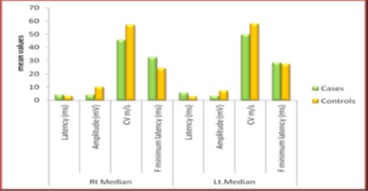Comparative Peripheral Nerve Conduction Study of Median and Ulnar nerves in Type-2 Diabetics with Age and Sex Matched Normal Subjects.
Abstract
Background: Diabetes Mellitus affects the peripheral nervous system, and in uncontrolled diabetes, symptomatic neuropathy is one of the commonest incapacitating complications. Diabetic neuropathy can be detected at an early stage using Electrodiagnostic tests. Nerve Conduction Study (NCS) is the most sensitive, reliable, non-invasive and objective means of investigations of Diabetic Polyneuropathy. If detected, the proper treatment can be instituted in the early stages with a good outcome. As the peripheral nerve can regenerate, a line of treatment can be planned accordingly. Based on this background, the present study aimed to evaluate the comparative peripheral nerve conduction study of median and ulnar nerves in people with type-2 diabetes with polyneuropathy.
Methods: A total of 58 subjects were included in the present study, 29 subjects with Diabetic Neuropathy and 29 age and sex-matched healthy subjects. Motor and Sensory nerve conduction studies were conducted in both upper and lower limbs nerves using bipolar surface electrodes with RMS EMG EP MARK-II machine. Statistical analysis was done using SPSS 20.0.
Results: A definite decrease in amplitude and nerve conduction velocities of both the sensory and motor components, axonal and demyelinating type, significantly correlating with higher HbA1c levels. F minimum latencies of Median nerves were increased, possibly more of demyelinating type of polyneuropathy.
Conclusion: NCS being a simple, harmless, non-invasive and objective technique along with the easy interpretation of results, can be used routinely to evaluate the status of nerves in patients with Type 2 Diabetes Mellitus to prevent a more disabling state the earliest.
Downloads
References
Stumvoll M, Goldstein BJ, van Haeften TW. Type 2 diabetes: principles of pathogenesis and therapy. Lancet 2005 Apr 9-15;365:1333-46.
King H, Aubert RE, Herman WH. Global burden of Diabetes, 1995-2025: prevalence, numerical estimates, and projections. Diabetes Care 1998 Sep;21(9):1414-3.
World Health Organization. Global report on diabetes. Geneva: World Health Organization; 2016.
Fowler, Michael J. "Microvascular and macrovascular complications of diabetes. Clinical diabetes 2008: 77-82.
Erratum. American Diabetes Association. Classification and diagnosis of diabetes., In Standards of Medical Care in Diabetes-2016. Diabetes Care 2016;39(1):S13-22.
Frier BM. Diabetes mellitus, 20 the d. In: Boon A College R. Davidson's Principles and practice of medicine, Churchill Living stone, 2006:805-48.
Alzahrani. "Determination of Serum Adiponectin Levels in Type 2 Diabetes Patients of the Saudi Population in the Al-Jouf Region." Romanian Journal of Diabetes Nutrition and Metabolic Diseases 2020: 257-262.
Salam RS, Laikangbam S, Tina D, Wahengbam DD, Bishnupriya P, Purnima MD. Adiponectin and Body Mass Index in Type 2 Diabetes Mellitus. International Journal of Contemporary Medical Research 2020;04:1-4.
Nagarathna R, Bali P, Anand A, Srivastava V, Patil S, Sharma G, et al. Prevalence of Diabetes and Its Determinants in the Young Adults Indian Population-Call for Yoga Intervention. Front Endocrinol 2020 Dec 11;11:507064.
Su N, Zhao N, Wang G, Wang L, Zhang Y, Li R, et al. The Effects of Adiponectin and Adiponectin Receptor 1 Levels on Macrovascular Complications Among Patients with Type 2 Diabetes Mellitus. Cell Physiol Biochem. 2019;52(2):225-231.
Krarup C. Nerve conduction studies in selected peripheral nerve disorders. CurrOpin Neurol. 2002 Oct;15(5):579-93.
WHO. "Global Report on Diabetes. World Health Organization. 2016;1:1-6.
Ziegler D, Gries FA, Spüler M, Lessmann F. The epidemiology of diabetic neuropathy. DiaCANMulticenter Study Group. Diabet Med 1993;10:2:82-86.
Muthuselvi K, Shanthi M, Ethiya N. Comparison of Nerve Conduction Studies in Geriatric Normal and Diabetic Subjects.2015;4(4):2013–5.
Magladery JW, Mcdougal DB. Electrophysiological studies of nerve and reflex activity in normal man. I. Identification of certain reflexes in the electromyogram and the conduction velocity of peripheral nerve fibers. Bull Johns Hopkins Hosp 1950;86(5):265-90.
Lambert EH. "Diagnostic value of electrical stimulation of motor nerves." Electroencephalogr Clin Neurophysiol 1962;22: 9-16.
Gilliatt RW, Sears TA. Sensory nerve action potentials in patients with peripheral nerve lesions. J Neurol Neurosurg Psychiatry 1958;21(2):109-18.
Kakrani AL, Gokhale VS, Vohra KV, Chaudhary N. Clinical and nerve conduction study correlation in patients of diabetic neuropathy. J Assoc Physicians India 2014;62(1):24-7.
Kimura J. Long and short of nerve conduction measures: reproducibility for sequential assessments. J Neurol Neurosurg Psychiatry 2001;71(4):427-30.
WagmanIh, Lesse H. Maximum conduction velocities of motor fibers of ulnar nerve in human subjects of various ages and sizes. J Neurophysiol. 1952;15(3):235-44.
American Diabetes Association, "Standards of medical care in diabetes". Diabetes Care 2017;40 (1): S1–35.
Misra UK, Kalita J. Clinical neurophysiology: nerve conduction, electromyography, evoked potentials. Elsevier Health Sciences 2019:14-19.
Verma, Anita, Swati M, Prashant K. "Sensory nerve conduction studies in non-insulin dependent diabetes mellitus (NIDDM) patients without symptoms of peripheral neuropathy and healthy volunteers: a comparative study." Int J Basic ApplPhysiol 2015: 158-62.
Ali, Zahed. "Role of electrodiagnostic tests in early detection of diabetic neuropathy." Bangladesh Journal of Neuroscience 2008: 34-44.
Kong X, Lesser EA, Potts FA, Gozani SN. Utilization of nerve conduction studies for the diagnosis of polyneuropathy in patients with diabetes: a retrospective analysis of a large patient series. J Diabetes Sci Technol. 2008;2(2):268-74.
Kimura, Jun. "The blink reflex." Electrodiagnosis in disease of nerve and muscle. Principles and practice 2001.1-9.
Hamdan, Farqad B. "Nerve conduction studies in healthy Iraqis: Normative data." Iraqi J Med Sci 2009: 75-92.
Buschbacher RM. Median nerve F-wave latencies recorded from the abductor pollicis brevis. Am J Phys Med Rehabil. 1999 Nov-Dec;78(6):S32-7.
Budak F, Efendi H, Apaydin R, Bilen N, Komsuoglu S. The F response parameters in Behçet's disease. Electromyogr Clin Neurophysiol 2000 Jan-Feb;40(1):45-8.
Asad A, Hameed MA, Khan UA, Butt MU, Ahmed N, Nadeem A. Comparison of nerve conduction studies with diabetic neuropathy symptom score and diabetic neuropathy examination score in type-2 diabetics for detection of sensorimotor polyneuropathy. J Pak Med Assoc. 2009;59(9):594-8.

Copyright (c) 2021 Author (s). Published by Siddharth Health Research and Social Welfare Society

This work is licensed under a Creative Commons Attribution 4.0 International License.


 OAI - Open Archives Initiative
OAI - Open Archives Initiative


